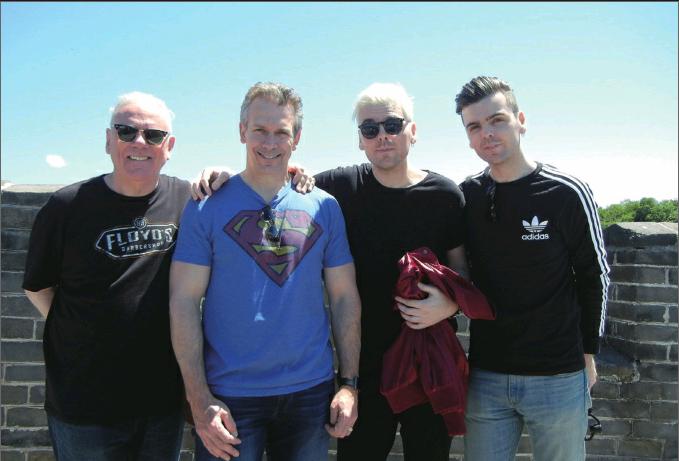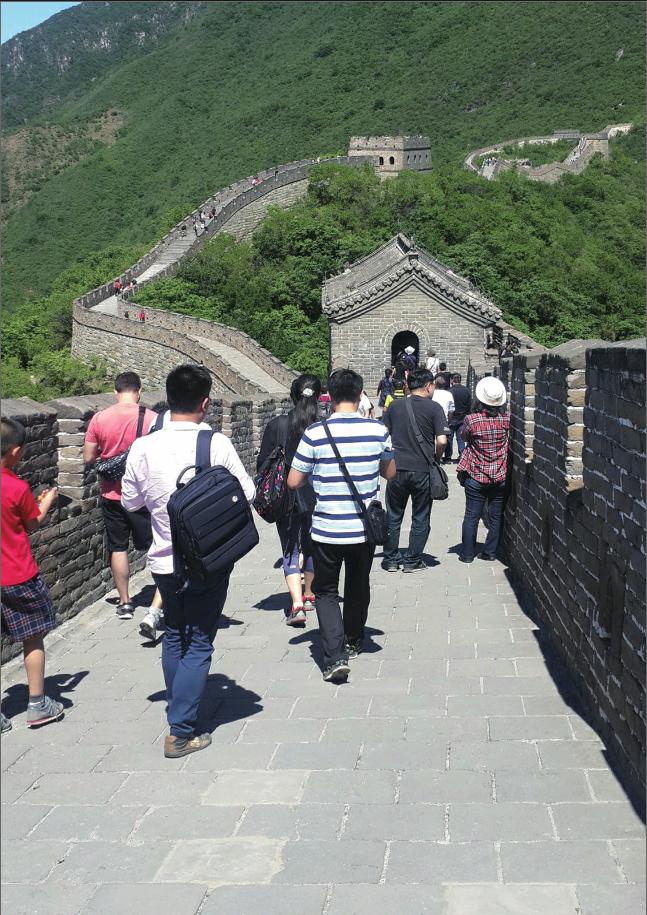A Wall of Unity
2017-06-15BySudeshnaSarkar
By+Sudeshna+Sarkar


Vusi Nhlapo had a lot of diffi culty covering the stretch of the Great Wall in Beijing known as Mutianyu. It was not because of the steepness of this part of the 14th-century fortification—it was because every two steps, the 43-year-old majestic-looking South African was stopped by strangers who wanted to take selfi es with him.
“Its been like this all the way,” Nhlapos companion Miguel Simoes said wryly. The four South Africans were climbing the wall on their fi rst visit to China on May 13. The trip had been organized by Johannesburg-based Chatz Connect, a prominent cellular dealer, as an incentive for high-performing sales agents. It was also a relations-building exercise for South African sales personnel like Simoes and Nhlapo, and Oyisa Besman, a store builder who meant to network with Chinese companies to expand her business.
For the South Africans, the Great Wall is a symbol of China, a sign of its past and a portent of the future. “China will probably be the next superpower,” Simoes said. “But if you look at the Great Wall, they were already a superpower when they built it. The wall is a cultural platform and a great icon.”
A brief history
Built in 1368 on the ruins of the ramparts erected by an earlier dynasty, the Mutianyu section, while being one of the best-preserved parts of the Great Wall, has had modern touches put in place. Today, it has a cable car transport system, a toboggan, a hotel and a restaurant. As recently as 2014, the Mutianyu Great Wall comprehensive service district was unveiled to give tourists a better travel experience. It has a museum, a Great Wall culture exhibition center, a visitors center and a commercial street. The quaint one-story farmers cottages on the way to the wall have been renovated to offer food and homestays.
“Mutianyu provides an insight into Chinas well-preserved ancient defense system,”said Wang Zhigang, Vice General Manager of Financial Street Holdings, the parent company of the Mutianyu Great Wall Tourism Co., which looks after the maintenance and development of this section. “The Ming Dynasty (1368-1644) rulers set up a four-layer defense system comprising the wall, signal towers, surrounding towns and fi nally, the cities.”
The wall has regularly spaced casements that were actually archers windows. This is where the archers stood stationed with their long bows, ready to let fl y volleys of arrows on approaching enemies. Wang said there are signal towers every 100 meters on the wall, which were used for communication. “The Mutianyu is not just the best preserved but also the greenest of the wall segments,” he said with pride. “This area has 96 percent forest cover. Besides, Mutianyu is a platform for international exchange. Nearly 70 percent of the visitors are foreigners. Israeli Prime Minister Benjamin Netanyahu has been here, and so has the former U.S. fi rst family, Barack and Michelle Obama.”
Thanks to this tourist flow, Mutianyu generates over 100 million yuan ($14.5 million) in revenue annually. A section of the wall is covered by a canvas where visitors can scribble their names and leave messages. They are from countries as diverse as Azerbaijan, Argentina, Papua New Guinea and Canada.
Marathon as meeting point
Three years ago, to reach out to more people, a marathon was started on this section of the wall, following the Great Wall Marathon, which started on the Tianjin section of the Great Wall in 1999. “This is the riskiest marathon,” Wang said. “We have added 3 km more to the distance covered by other marathons, taking the total distance to about 44 km.”
Over 10,000 people have taken part in this mother of all marathons in its two editions so far. Wang is one of them. “It is nearly a fi ve-hour run,” the 49-year-old said. “Every day, I run 10 km in preparation. It is a heady exercise, giving you a feeling of release from all tension. It is tough but half the battle is fought in the mind. I reserve my strength for the diffi cult bits.”
Wangs company plans to start a bicycle race on the wall once the route has been charted out. The company is also identifying places where there could be more historical artifacts underground. Once the areas are identifi ed and negotiations completed with the land owners, excavation will start.
“Our aim is to promote the Great Wall culture of perseverance and consistency,” Wang said.
Leslie Goldberg has another quality to add to it: endurance. It is a characteristic that appeals to the 64-year-old businessman from Toronto.
Goldberg first came to China in 1986, looking for business in Shenzhen and Hong Kong. This time, several visits later, he was back for business in Shentou, a town in Shandong Province. Mixing business with pleasure, he decided to climb Mutianyu.
“The Great Wall is the spokesperson of China, its international face,” he said. “One of the ancient wonders of the world, it is still standing. It speaks volumes for the Chinese people.”
Comic connections
Steve McGarry was spokesperson for a quartet of cartoonists who were exploring the wall prior to leaving for Changchun, northeast Chinas Jilin Province, to attend the China-U.S. Comic Art Summit in mid-May.
Hosted by Jilin Animation Institute, an art college specializing in animation, comics and games, the event was the meeting point of comic artists, cartoonists and illustrators.
The quartet comprised Tom Richmond, a 51-year-old American freelance cartoonist whose portfolio included the venerable Mad magazine; McGarry himself, a syndicated British cartoonist and illustrator who has done illustrations for Hollywood animation fi lms like Minions and Despicable Me; and his twin sons Luke and Joe, who are into making animated videos and music posters.
“Cartoons are the most accessible art form,”McGarry said. “No matter what your language is, you can always understand what a cartoon is trying to say.”
McGarry, who is also president of the National Cartoonists Society in the U.S., said they would be extending friendship among the student community at the comic art summit, telling them about the art in the U.S. and the opportunities it presents. “We are here to open a two-way street,” he said. “We are here to learn as well, learn different approaches and sensibilities. The technique in Chinese and U.S. cartoons is the same but the approach is different, and the humor is different. However, the success of films [where China meets the West] like Kung Fu Panda and the Fast and Furious [franchise] is evidence that this approach can work.”
As the visitors, each with a different background and goal, were united for the moment during their trip to the Great Wall, Nhlapo figured out the irony, “When the Great Wall was built, it was meant to create a border. But now it represents the borderlessness of the world through the convergence of all these international tourists.”
